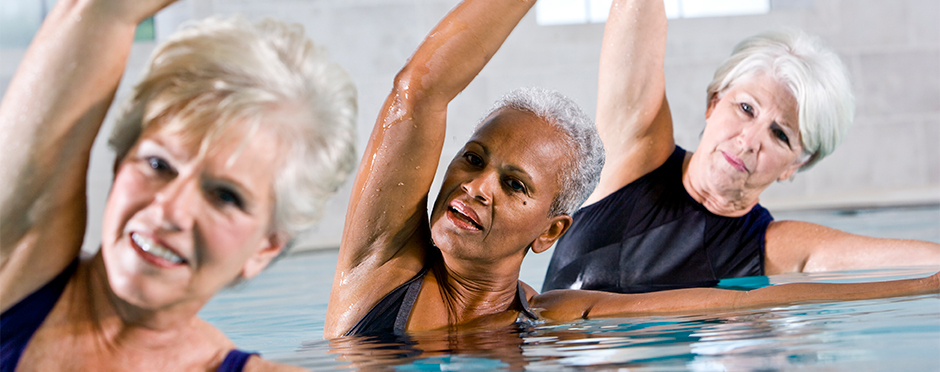
6 Water Activities to Try this Summer
1 CommentSwimming is a fun, recreational activity that can also be an effective workout. Even if you are a non-swimmer, you can still enjoy and benefit from exercise in the water. And if you are already a swimmer, why not take it to the next level?
Before starting a water fitness routine, it is important to know the basics of water safety. These can be found in my previous blog, titled “Swimming 101: Having Fun & Staying Safe in the Water.” It is also a good idea to consult your physician before starting a new exercise program.
As with any sport, you can join an aquatic exercise group/class or go it alone. There are advantages to both, so choose what works best for you. Some venues have both a warm water therapy pool and a standard cool water lap pool. Depending on your needs, either warm or cool water may be appropriate. Read below for some activities to try in the pool this summer (or all year long!):
1. Water Walking
One of the more basic activities you can do in the water is water walking. Stay in water of a consistent depth, such as waist deep or chest deep. Simply walk laps or widths of the pool. To ramp this activity up, you can also try running in the pool. This is a great opportunity to increase your heart rate, as well as keep up your fitness level while recovering from a running injury.
2. Leg Exercises
Another good entry level exercise is to stand in the water, hold onto the pool wall and perform a variety of leg exercises. Suggestions include rising up on toes, mini squats, side leg kicks, heel toward buttock, forward leg kicks and marching.
3. Treading Water
If you are confident in deeper water, you can try treading water for short periods of time. Of course you can use your arms along with your legs in the treading process, but for a challenge you can raise your arms out of the water. To challenge yourself further, try changing directions by turning your body by 90 degree increments.
4. Water Classes
Most aquatic facilities offer classes in water aerobics or aquacise. These classes can be quite challenging but can also be beneficial for people with arthritis or other musculoskeletal conditions. The purchase of water aerobic shoes helps increase traction on the bottom of the pool, resulting in foot protection and more effective exercise.
5. Create Exercise Routines
The more experienced swimmer should approach their water workouts with some forethought. Start with an easy warm up. Plan out different drills, skills and series ahead of time. Incorporate form, different strokes, kicking, endurance and speed into your water exercise routines.
Another way to improve water workouts is by changing things up. If you usually take a breath every two strokes during freestyle, consider breathing every three strokes so that you are turning your head to breathe to left and right sides. This will help you concentrate on form, improve muscle balance and symmetry. You can also try breathing every four strokes, or even four strokes then two strokes and repeating. If you know how to swim other strokes besides freestyle (crawl), then incorporate those into your workouts. Push yourself to a longer distance swim without resting to improve endurance. Grab a kickboard and work on flutter kick (freestyle), dolphin kick (butterfly) and frog kick (breaststroke). Proper swim kick comes from the hip and is an essential component of efficient swimming.
6. Work on Your Speed
For a real challenge, use the pool’s time clock or your watch and work on your swimming speed by doing repeats, which are similar to repetitions. When doing repeats, try to do each one in the same amount of time (or faster), without slowing down. That said, it is important to not let your form suffer for speed. Keep the water level near your eyebrows and keep your elbows high. Don’t let your kicking drop.
Also consider using equipment, like paddles on your hands or pulling a buoy between your legs. Both will make your arms work harder to get you through the water. Some will wear two bathing suits or a drag suit to increase resistance in the water. Swim with a partner to challenge each other. If you are a former swimmer, or are interested in taking your swimming to the next level, check out your local Master’s Swimming Club and ask for some pointers.
Cooling Down
After your water exercise, cool down with some easy laps and/or stretching. If you don’t have any medical restrictions, consider a short time in the hot tub/whirlpool. Also make sure to drink enough water to stay hydrated before, during and after your workout.
Should unusual muscle soreness or pain result after swimming, schedule a Free Assessment at your nearest Athletico so you can start the healing process and get back in the water. Free Assessments are available in-clinic and virtually through our Telehealth platform.
The Athletico blog is an educational resource written by Athletico employees. Athletico bloggers are licensed professionals who abide by the code of ethics outlined by their respective professional associations. The content published in blog posts represents the opinion of the individual author based on their expertise and experience. The content provided in this blog is for informational purposes only, does not constitute medical advice and should not be relied on for making personal health decisions.

1 Comment
Beno Luxury Rentals
Thanks for sharing this. I will keep these in mind while performing water activities dubai. I am from UAE so water activities dubai is my favourite thing to do in summer